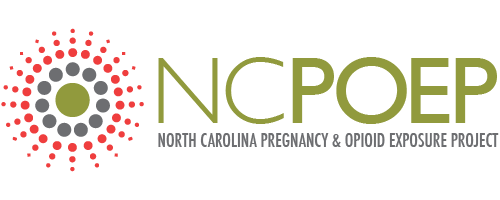![Figure 1. NC Emergency Department Visits for Medication/Drug Overdoses, Childbearing Years, 2012 Adapted from NC DETECT (2012)<sup><a href="#_ftn5" name="_ftnref5">[5]</a></sup>](/wp-content/uploads/2014/11/section02_chart_01.png)
Figure 1. NC Emergency Department Visits for Medication/Drug Overdoses, Childbearing Years, 2012 Adapted from NC DETECT (2012)[5]
Nationally, the misuse and abuse of opioids has been called an epidemic.
[1]
Privately and publicly insured women of childbearing age have been prescribed opioids at high rates, with an average of 27.7% and 39.4% respectively over a four year period.[2] North Carolina has not been immune to the increased availability of prescription opioids, subsequent diversion, and increased opioid use disorders. Statewide in North Carolina, from 1997 to 2010, the federal Drug Enforcement Administration (DEA) recorded an 839% increase in sales of the opioid oxycodone.[3] From 2010 to 2012, an estimated 4% of the North Carolina population older than 12 years reported non-medical use of prescription pain relievers.[4] Across the state, rates of emergency department visits due to drug overdoses have also surged with opioids and benzodiazepines leading the list of ingested substances. For Women of childbearing age, including teens, the rates of overdoses treated in emergency departments are surpassing the rates of men (see fig.1).
![Figure 2. Rates of Infants Identified with Drug Withdrawal Syndrome by NC hospitals, per 100,000 Live Births. Adapted from North Carolina State Center for Health Statistics, Injury Epidemiology and Surveillance Unit (2014).<sup><a href="#_ftn7" name="_ftnref7">[7]</a></sup>](/wp-content/uploads/2014/11/section02_chart_02.png)
Figure 2. Rates of Infants Identified with Drug Withdrawal Syndrome by NC hospitals, per 100,000 Live Births. Adapted from North Carolina State Center for Health Statistics, Injury Epidemiology and Surveillance Unit (2014).[7]
The combination of increased availability of opioids and increasing prevalence of substance misuse has unleashed a cascade of negative effects as noted in a recent report on drug and alcohol dependence in North Carolina: “…it is now clear that opioid sales, chronic non-medical drug use, emergency department visits, substance abuse treatment admissions, and deaths are increasing in parallel.”
[2] We would add that this parallel upward trajectory includes opioid-exposed pregnancies. The increased availability of opioids has negatively affected pregnancy outcomes of women who have become opioid dependent and their infants who had been exposed to opioids in utero. Data from the National Survey on Drug Use and Health indicate the rate of heroin use by pregnant women has increased somewhat over time whereas, in just the past decade, this population has experienced a 33% increase in non-medical use of prescription pain relievers.
[6] To obtain an estimate of the increase in opioid exposed pregnancies in North Carolina, we can look to the North Carolina State Center for Health Statistics, Injury Epidemiology and Surveillance Unit analysis of data from 2004 to 2012 that reported a 511% increase in infants diagnosed with drug withdrawal syndrome.
[7] Of the 4,037 women of childbearing age with opioid-use disorders who entered treatment through the North Carolina public system in 2013, approximately 4% or 162 women were pregnant.
[8] Although the withdrawal symptoms can be treated, in some cases opioid use and, ultimately withdrawal in infants might be prevented with better information prior to conception, and ideally, best managed through family centered collaboration of well-informed care providers.
References
[1] Hayes, M J; Brown, M S. Epidemic of prescription opiate abuse and neonatal abstinence. Journal of the American Medical Association. 2012;307:18 1974-1975
[2] Ailes, E C, Dawson, A L, Lind, J N. et al.MMWR Morb Mortal Wkly Rep 2015;64;38-41
[3] Modarai F, Mack K, Hicks P, Benoit S, Park S., Jones C, Proescholdbell S, Ising A, Paulozzi L. Relationship of opioid prescription sales and overdoses, North Carolina. Drug and Alcohol Dependence
[4] Substance Abuse and Mental Health Services Administration, Center for Behavioral Health Statistics and Quality. (January 8, 2013). The NSDUH Report: State Estimates of Nonmedical Use of Prescription Pain Relievers. Rockville, MD.
[5] NC DETECT North Carolina Injury and Violence Prevention. Annual Injury Report, North Carolina Emergency Department Visits For Injuries Due to Medication or Drug Overdoses.2012.
[6] Substance Abuse and Mental health Services Administration (SAMHSA) National Survey on Drug Use and Health, 2003, 2004, 2005, 2006: Table 7.51B. 2006.
[7] North Carolina State Center for Health Statistics, Injury Epidemiology and Surveillance Unit. ‘Medication & Drug Overdoses North Carolina’ presentation. Overdose Summit July 2014.
[8] N.C. Department of Health and Human Services, Division of MH/DD/SAS, correspondence 10/3/14
|
![Figure 1. NC Emergency Department Visits for Medication/Drug Overdoses, Childbearing Years, 2012 Adapted from NC DETECT (2012)<sup><a href="#_ftn5" name="_ftnref5">[5]</a></sup>](/wp-content/uploads/2014/11/section02_chart_01.png)
![Figure 2. Rates of Infants Identified with Drug Withdrawal Syndrome by NC hospitals, per 100,000 Live Births. Adapted from North Carolina State Center for Health Statistics, Injury Epidemiology and Surveillance Unit (2014).<sup><a href="#_ftn7" name="_ftnref7">[7]</a></sup>](/wp-content/uploads/2014/11/section02_chart_02.png)



